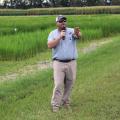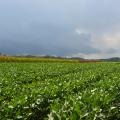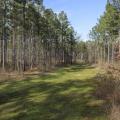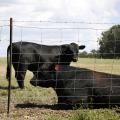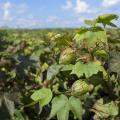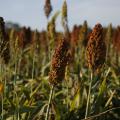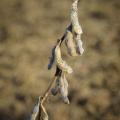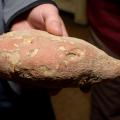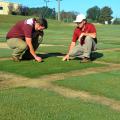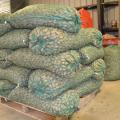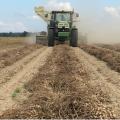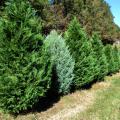Crop Report from 2017
Combines began rolling in Mississippi Delta rice fields as soon as growers marked the beginning of August, but wet weather soon shut down early harvest attempts.
Bobby Golden, a rice and soil fertility agronomist with the Mississippi State University Extension Service, said yields are expected to be favorable when fields are dry enough for harvest, though overall acreage will be down this year.
STARKVILLE, Miss. -- Mississippi’s row crops have had enough rain, and most fields just need sunshine.
Erick Larson, grain crops specialist with the Mississippi State University Extension Service, said corn is mature and will gain no benefit from additional moisture. In the first couple of weeks of August, skies were overcast or rain was falling across most of the state.
STARKVILLE, Miss. -- The combination of a middling timber market, a pine beetle infestation and wet weather is doing Mississippi tree farmers no favors this year.
Fortunately, a new sawmill in the state and the prospect of increased manufacturing gives reason for optimism long-term.
Biewer Sawmill began operations this year in Newton. Glenn Hughes, a forestry professor with the Mississippi State University Extension Service, said this indicates an upswing for the state’s forest product industry.
STARKVILLE, Miss. -- Mississippi producers are optimistic that the remnants of Hurricane Harvey that moved through the state in late August were not enough to stop corn harvests from reaching a new record.
As of Aug. 27, the U.S. Department of Agriculture estimated 51 percent of the corn crop was harvested. Growers had a few more days to tackle remaining acres before rains came through the state. USDA estimated that 78 percent of the crop was in good or excellent shape.
Erick Larson, grain specialist with the Mississippi State University Extension Service, said many early yields exceeded 200 bushels an acre, with dryland acreage producing at almost the same rate as irrigated acres. The state’s record average yield was 185 bushels set in 2014.
The first shipment of U.S. beef to China in more than 13 years reached its destination in June, and Mississippi cattle producers are beginning to see modest rewards of new market access.
Current cattle prices in Mississippi are up from a year ago. Lightweight cattle are $1.67 per pound, while heavyweight feeder cattle are around $1.35 per pound. A year ago, lightweight cattle were $1.55 per pound, and heavyweight cattle were in the range of $1.17 per pound.
“The cattle market has exhibited strong demand through most of 2017 despite the increased supply of cattle in the U.S.,” said Josh Maples, an agricultural economist with the Mississippi State University Extension Service. “Prices have generally decreased over the past month, which is due to a combination of seasonal factors and the increased supply.”
STARKVILLE, Miss. -- Rain, cool weather, more rain and some wind have slowed cotton maturation, but since the crop was a little behind schedule, the damage may be less than if harvest were already underway.
Darrin Dodds, cotton specialist with the Mississippi State University Extension Service, said recent weather is causing some yield loss, but it is hard to estimate how much.
“Being late to a degree helped the crop because rain did not string out open cotton, but given that we are running out of heat, we may have been better off with an earlier crop that had been defoliated and was standing up when the rain came,” Dodds said.
STARKVILLE, Miss. -- Mississippi’s grain sorghum acreage is at an historic low, and market prices are not much better, but yields should be good.
Erick Larson, grain crops specialist with the Mississippi State University Extension Service, said that when market incentives went away after 2015, so did farmers’ desire to plant grain sorghum, also known as milo. State growers may have planted 10,000 acres this year, the fewest since record keeping began in 1929.
Official numbers show Mississippi’s soybean crop is ahead of schedule and in good shape, but many fields have actually spent a wet month waiting for harvest.
Trent Irby, Mississippi State University Extension Service soybean specialist, said this delay -- caused by frequent, heavy rains -- impacted a portion of the state’s crop.
STARKVILLE, Miss. -- Mississippi producers are growing 28,100 acres of sweet potatoes this year, but not one of those is below the northern third of the state.
What keeps growers in south Mississippi from planting the increasingly popular crop? Weevils are mostly to blame.
“Sweet potatoes grown in south Mississippi require more inputs to exclude weevils from fields and have stricter regulations as far as how and where sweet potatoes can be shipped and marketed,” said Stephen Meyers, sweet potato specialist with the Mississippi State University Extension Service.
Mississippi’s sod producers experienced good news and bad news from 2017 weather conditions. Jay McCurdy, turfgrass specialist with the Mississippi State University Extension Service, said the good news was a modestly warm spring with timely rainfall provided good growing conditions for most of the state’s sod farms. The bad news was the same weather promoted the growth of weeds and fungal diseases.
Pumpkins are a minor agricultural crop in Mississippi, but demand increases every year as consumers use them mostly for decoration.
Casey Barickman, Mississippi State University Extension Service vegetable specialist and Mississippi Agricultural and Forestry Experiment Station researcher, said the state has an estimated 500 to 600 acres of pumpkins.
As the time for pecan harvest approaches, some Mississippians are contemplating adding new orchards or expanding or renovating old ones.
Eric Stafne, fruit and nut crops specialist with the Mississippi State University Extension Service, said growers want to capitalize on the demand for pecans, which is increasing domestically and overseas.
Growers managed major disease problems in the peanut crop this year to produce high yields and good profits.
RAYMOND, Miss. -- After two years of drought, Mississippi Christmas tree growers welcomed the extra rain in 2017.
“In a few low-lying areas, excessive rain in May and June waterlogged the soil and killed some trees, but this was not widespread,” said Stephen Dicke, a forestry specialist with the Mississippi State University Extension Service. “We will always take more rain over less rain.”

